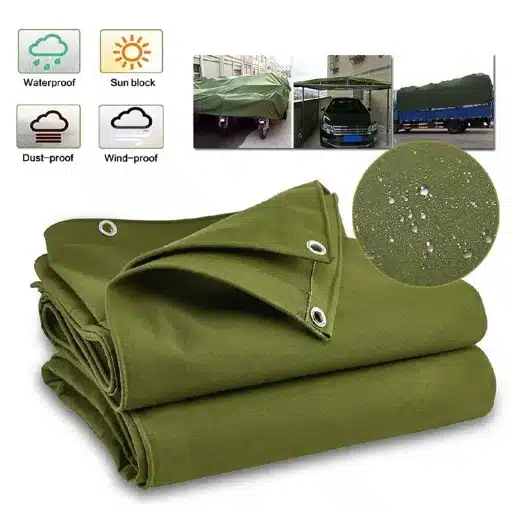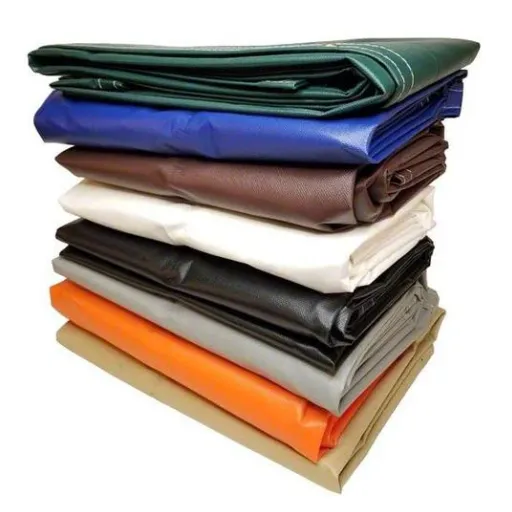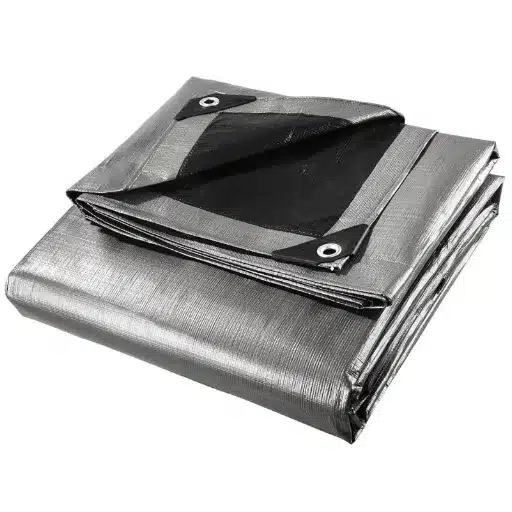Industrial tarps serve as the ultimate protection for equipment, materials, and worksites from extrusion by rough environmental conditions. Heavy-duty tarps meant to withstand all sorts of weather provide ultimate protection for all applications, be it in construction, agriculture, transport, or storage. This article deals with this very issue of how high-performance tarps protect valuable assets while enhancing operational efficiency. We take them from their construction and durability of material types through the selection of a suitable tarp for their needs. Strong winds, hard rain, and intense sunlight; any situation given industrial tarps work to ensure dependable coverage that lasts and brings peace of mind.
Understanding Tarps
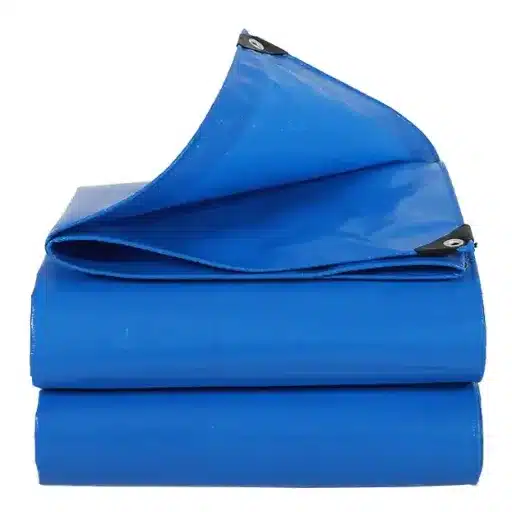
What is a Tarp?
A tarp, short for tarpaulin, is a large sheet of any flexible material, often strong, to afford shelter from rain, sun, wind, or dust. In general, tarps are made of polyethylene, canvas, or vinyl materials that could be coated or laminated to resist water, UV rays, and abrasion. These covers have multi-purpose uses, with reinforced edges and grommets to facilitate fastening for various applications. The main functionalities of tarps are covering equipment, shielding construction sites, and sheltering agricultural or industrial products during storage or transit. Convertible to all sizes, highly tensile yet lightweight, and hence, tarps are indispensable to almost every industry from construction to logistics, agriculture, and disaster relief.
The Different Types of Tarps
There are several types of tarps, each suited for specific uses and environmental conditions. The following is an overview of the most commonly used tarps:
Polyethylene (Poly) Tarps
Poly tarps are crafted out of woven polyethylene fibers, renowned for their strength, resistance to water, mildew, and UV rays. Thus, they are mostly used to cover outdoor things, construction sites, and temporary shelters due to their high resistance to tearing even when light in weight.
Canvas Tarps
Canvas tarps are heavy-duty cotton or synthetic fabric tarps with breathability and water resistance that can be used to cover machinery, industrial materials, or flatbed loads. Canvas tarps rarely develop condensation buildup, which is critical to protecting sensitive surfaces.
Vinyl Tarps
Because these tarps are fabricated from polyvinyl chloride, they possess qualities of very high resistance to water, oil, chemicals, and abrasion. As such, vinyl tarps are popular for most demanding industrial and agricultural applications, including containment and long-term outdoor storage.
Mesh Tarps
Mesh tarps have interwoven materials that allow airflow yet provide shade and containment for debris. The tarps are used as screens for construction sites, covers for truck beds, and sporting grounds where a compromise between visibility and protection is required.
PVC-Coated Tarps
These are tarps combining a fabric’s strength and flexibility with a robust, durable PVC coating. The tarps bear wide applications in marine settings owing to high saltwater corrosive resistance and durability to weather extremes.
Key Takeaway: Selecting the correct type of tarp with regard to its material composition, intended use, and environmental conditions is vital in providing a reliable and long-lasting solution for any application.
Tarps Use in Different Industries
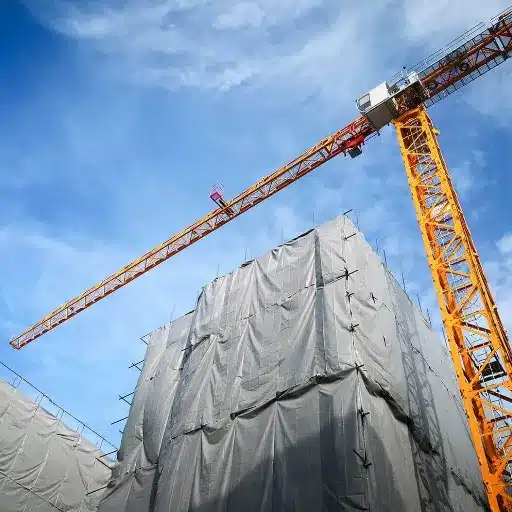
Industries use tarps due to the vast and fine range of applications dependent on the versatility of tarps, their durability, and accommodation to fine conditions. Below are some primary industrial uses based on recently updated data:
🏗️ Construction Industry
Tarps in construction are mainly used to cover equipment, materials, or work areas from dust, rain, and UV exposure. Heavy-gauge types of tarp are applied as scaffolding enclosures, temporary roofing, and containment systems so as to provide an additional layer of safety to workers and ensure work proceeds even when bad weather strikes.
🌾 Agriculture
In agriculture, tarps are used to protect crops, cover silage, and collect water. They inhibit moisture build-up while shielding product and machinery from extreme weather factors such as harsh sun or random showers.
🚛 Transport and Logistics
In this sector, tarps are used to cover and secure a wide array of materials during transportation. From tarps for flatbed trailers to truck covers, nothing can ensure better protection of goods against debris, rainfall, and wind on a long haul.
🏬 Warehouse and Storage
Tarps are deployed as temporary storage covers to protect products and equipment against dust, water, or humidity. PVC-coated tarps tend to be preferred because of durability and resistance to environmental factors.
🎪 Event Management
Tarps are used to raise temporary structures such as tents, stages, and floor coverings for various current outdoor events and exhibitions. The weather-resistant tarps will keep the events going irrespective of an attack of adverse weather.
⚓ Marine and Boating
The marine industry heavily utilizes tarps for their saltwater resistance. They use tarps for covering boats, dock enclosures, and protecting marine equipment from weather extremes and corrosion.
As these industries keep evolving with advancements in Material Science and production technologies, tarps have been instrumental in meeting their needs.
Heavy Duty Industrial Tarps
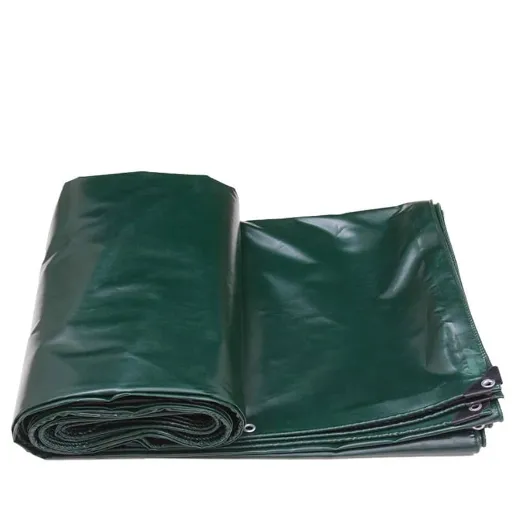
Benefits of Heavy-Duty Tarps
These tarps are very durable and versatile, thus considered an asset in various fields. These tarps are made of heavy materials such as polyethylene or vinyl-coated polyester, which allow them to create resistance against environmental hazards, heavy wear, and long exposure to UV rays. Being a principal benefit, this tarp weather protection resists rain, snow, or harsh sun from coating that collects on machinery, an unfinished base structure, or goods. In addition, however, they perform well against tears and, hence, can be called long-lasting even in rugged applications such as working on a construction site or on a farm.
According to recent search trends, there seems to be a rise in interest around heavy-duty tarps for custom applications, such as containment projects on a large scale, and industrial covers customized in specific dimensions. Heavy-Duty Tarps are also cost-efficient because heavy-duty tarps seldom require replacement due to their robust nature. Recently, with all the modern advancements of reinforced seams and multi-layer coatings, the industrial and commercial users are faced with more challenging requirements that these tarps can now answer to adequately.
Materials Used in Heavy Duty Tarps
Materials for manufacturing heavy-duty tarps are an amalgamation of the most highly durable materials engineered for maximum strength, weather resistance, and longevity. Polyethylene and polyvinyl chloride are two majorly used materials. Polyethylene tarps comprise woven HDPE fibers with LDPE coatings, which make them highly resistant to tearing, U.V rays, and water. PVC tarps, on the other hand, consist of polyester scrim fabric coated with polyvinyl chloride, granting it greater resistance to abrasion, corrosive chemicals, and extreme temperatures.
Polyethylene Features
- Woven HDPE fibers
- LDPE coatings
- UV ray resistance
- Water resistant
PVC Features
- Polyester scrim fabric
- PVC coating
- Chemical resistance
- Extreme temperature tolerance
Such materials are further upgraded with additional coatings, for example, those that prevent flames or mildew, to reach special industrial-grade levels of performance. Typically, grommets, hems, and seams are reinforced through heat welding for industrial applications or through hand stitching, machine sewing, or over-lock stitching for commercial applications under heavy stress. The addition of such design features along with the latest innovations in manufacturing technology is what has kept heavy-duty tarps indispensable in construction, agriculture, and transport where reliability under harsh conditions is essential.
Choosing the Right Heavy-Duty Tarp
In selecting the best heavy-duty tarp, many factors must be taken into account to ensure the highest level of performance and suitability for the purpose intended. Based on the new trend analysis and user questions, durability has remained a priority for most consumers. First, examine the material composition-polyethylene and vinyl tarps are the most preferred materials due to their very high tensile strength and resistance to UV rays, water, and mildew. Next, consider the thickness and weight rating of the tarp, since higher ratings usually translate into a tarp being more durable when under stress for extended periods of time. Another factor crucial to consider is how the tarp will ultimately be used-the tarps for construction sites are often expected to be flame retardant and rip resistant, whereas agricultural applications benefit from features that make the tarp breathable, yet waterproof. Also be clear on the grommet spacing and the means of reinforcement, as both these affect how easy it will be to install your tarp and how well it will hold together during use. Matching these considerations against your particular project needs should go a long way in making sure your tarp does an effective job for you for the long term.
✅ Key Selection Criteria:
- Material composition – Polyethylene vs. Vinyl
- Thickness and weight rating – Higher = more durable
- Intended use – Construction vs. Agricultural vs. Industrial
- Special features – Flame retardant, breathability, waterproofing
- Grommet spacing – Affects installation ease
- Reinforcement quality – Determines durability under stress
Industrial Tarps: Features and Specifications
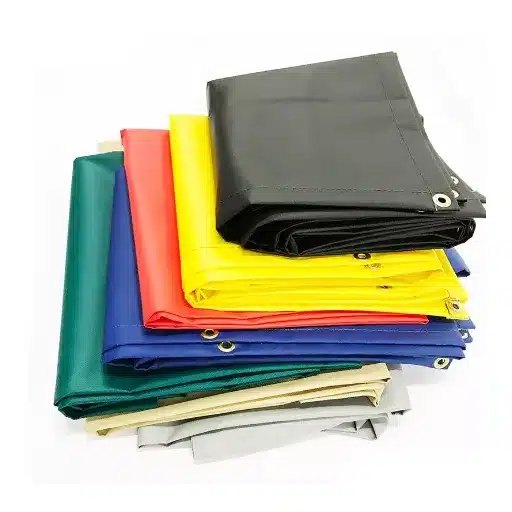
Industrial Strength Tarps
Industrial strength tarps are engineered in such a fashion so as to endure most extreme environments while preserving in certain conditions the brand of strength and performance it must demonstrate. Derived typically from heavy-duty materials in types of polyvinyl chloride (PVC), canvas, or high-density polyethylene (HDPE), these tarps offer extreme resistance to abrasions, tearing, or punctures. Often such tarps could be treated with ultraviolet (UV) inhibitors to prevent degradation due to prolonged sun exposure; meanwhile, another layer of coating that is flame retardant could be added to certain kinds in aid of ensuring safety if there is concern about fire hazard.
📊 Tarp Lifespan Data
A recent search data indicates that people intend to cast light on the question of tarp life-span during continued exposure. The life span of industrial strength tarps is highly dependent upon the type of materials used and the environment in which it is stored or applied, as well as the frequency with which maintenance is performed:
| Material Type | Expected Lifespan | Maintenance Requirements |
|---|---|---|
| PVC Tarps | 7-10 years | Regular cleaning, proper storage |
| Polyethylene Tarps | 1-5 years | Frequent inspection, UV protection |
Cleaning on a regular basis, checking to see if there are any signs of damage, and repairing them promptly are the things that increase the usable life of the tarp; therefore, they become worth the investment by various industries such as construction, farming, and transportation. A full understanding of these important factors will allow the user to confidently, both in accordance with their needs, procure tarps and maintain them accordingly.
Factors Taken into Account in the Durability of the Tarps
Several important views come into consideration when discussing the relevant data that are present about the durability of industrial tarps. Analyzing from recent sources, the greatest factor affecting the longevity of the tarp is its material composition. Heavy-duty PVC tarps resist abrasions, UV exposure, and harsh weather, usually lasting up to about 7-10 years, with decent maintenance. On the other hand, cheaper polyethylene tarps display comparatively less durability, in the range of about 1-5 years, depending on the nature of use and environmental exposure.
🔧 Manufacturing Quality
Heat-sealed seams and rip-stop weaves resist tearing and add structural strength, extending tarp life significantly.
🛠️ User Practices
Proper cleaning and controlled storage can increase tarp life by 20-30% compared to constant exposure.
☀️ UV Protection
UV-resistant coatings and antimicrobial treatments prevent material deterioration and contamination.
Search trends have recently also revealed the rising popularity of interest in UV-resistant coatings and antimicrobial treatments. This method would be of particular interest in the agriculture and transport industries, where tarps come into prolonged contact with the Sun and organic materials. When you select tarps with these features, their durability is improved and it also prevents the deterioration of the material and contamination.
Conclusion: Having the perfect tarp depends on factors such as balance between price and functionality, specific industry application, and factors related to durability. By using technology to their advantage and proper maintenance, the tarp will perform in real time with top-ranking usefulness in all industrial applications.
Vinyl Tarps versus Mesh versus Poly Tarps
A thorough comparison between vinyl, mesh, and poly tarps must take into consideration their qualities, durability, application, and cost-effectiveness. According to the data presented from recent research and trending factors, each tarp type has inbuilt specialties that give it an edge for specific industrial use and application.
| Feature | Vinyl Tarps | Mesh Tarps | Poly Tarps |
|---|---|---|---|
| Material | Polyvinyl chloride (PVC) | Woven mesh fabric | Polyethylene |
| Durability | ⭐⭐⭐⭐⭐ Excellent | ⭐⭐⭐ Good | ⭐⭐ Fair |
| Waterproofing | ✅ Completely waterproof | ❌ Not waterproof | ✅ Waterproof |
| Cost | 💰💰💰 High | 💰 Low | 💰💰 Moderate |
| Best Use | Heavy-duty industrial applications | Ventilation & shade applications | General purpose, short-term use |
📝 Summary Points:
- Vinyl tarps are the best choice for heavy-duty applications in industry due to their inherent ruggedness and long-term weather resistance, but they are costly.
- Mesh tarps do well where ventilation and light filtering are required, mainly in agriculture or construction.
- Poly tarps provide a cheap means for a quick, moderate application, lacking in durability, however, from vinyl tarps.
The job of choosing the appropriate tarp depends on the analysis of environmental conditions, its intended application, and cost. Following these steps ensures an organization or an individual in achieving a balance corresponding to the set performance and cost-efficiency.
Custom Tarps for Specific Needs
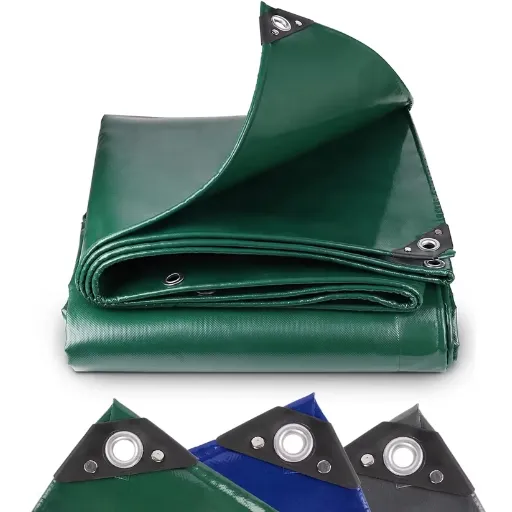
Why should one consider custom-made tarps?
While custom tarps can be manufactured to address special needs that standard-size tarps cannot address adequately, they meet the exact specifications for dimensions, materials, and functions in the sectors of transportation, agriculture, construction, and warehousing. For instance, data shows a huge growth in searches for made-to-order tarp solutions due to the rising demand for products meeting specific use cases and environmental challenges. Using custom tarps can offer better performance with advanced material selections such as UV-resisting fabric, fire retardant coatings, or enhanced hems that will withstand most demanding conditions. From another perspective, the use of custom tarps reduces any losses or inefficiencies produced due to improper fit or inadequate structural integrity: thus, these tarps will save a substantial amount of money on usage over a prolonged period.
✅ Perfect Fit
Exact dimensions eliminate waste and ensure optimal coverage
🎯 Specific Materials
Choose materials tailored to your environmental challenges
💰 Cost Savings
Reduce long-term costs through improved durability and fit
⚡ Enhanced Performance
Advanced features like fire retardancy and UV resistance
Ordering Custom Tarps
Ordering custom tarps is basically good if a certain production process is followed that ensures final fulfillment of the custom requirement for its intended application. It starts with the determination of the uses and the specifics of the need, such as dimension, type of material, and other extra features that may be of interest, for example, grommets or reinforced edges. All of these dimensions must be verified to avoid any problems during installation and use.
📋 Step-by-Step Ordering Process
- Define Requirements: Determine dimensions, material type, and special features needed
- Verify Measurements: Double-check all dimensions to avoid installation issues
- Research Suppliers: Find reputable manufacturers with good reviews and certifications
- Use Online Tools: Most suppliers offer custom specification builders on their websites
- Confirm Specifications: Review pricing, customization costs, and production timelines
- Request Samples: For large orders, consider requesting digital proofs or physical samples
- Monitor Production: Maintain communication throughout the manufacturing process
Afterward, research and choosing a reputable manufacturer or supplier is a vital step. Use your favorite search engines to find highly rated companies and institutions; consider what sort of reviews their customers offer, verifiable certifications they claim to uphold, and the basic standards associated with the materials they provide. Most suppliers will allow you to go to their sites, enter custom dimensions, specify material grades (polyethylene, vinyl, or canvas), and select optional features to build a user-specified specification sheet.
Once all specifications are mutually agreed upon, ensure that pricing is confirmed based on such factors as material and cost of customization work, aside from actual production lead times. Especially for large-scale or industrial applications, it may be worth requiring a digital proof or sample to prove relatively accurately the production correctness of the design. After acceptance of the design, the order is finalized, and from this moment, continuous monitoring of production deadlines with periodic updates will be maintained.
Pro Tip: This streamlined procedure joins various layers of intensive research and communication to efficiently create custom tarps that fit the environmental and operational requirements.
Examples of Custom Tarps Uses
Custom tarps are designed to satisfy the particular needs that crops up in various industries and applications by combining advanced materials and engineering. On this note, an engineer could cite the following examples:
🏗️ Construction and Renovation
In construction, custom tarps protect building materials, equipment, and unfinished buildings against adverse weather conditions such as rain, wind, or UV rays. Flame-retardant tarps are also commonly used for scaffolding enclosures to meet safety requirements and minimize hazards associated with fire.
🚛 Transport and Logistics
Custom tarps are used in securing and protecting cargo during transit. Applications include covers for truck beds, linings for shipping containers, and specialized coverings for oversized or irregular loads. This ensures that goods remain intact and shielded from external influences while observing federal safety standards for transportation.
🌾 Agricultural Practices
Custom tarps for agriculture are used as silage covers, hay bale protectors, and liners for temporary water storage. These tarps are manufactured to resist severe environmental factors such as heavy rainfall or continuous sunlight to ensure proper maintenance of agricultural assets.
🏭 Industrial Containment
Industries prioritize the use of heavy-duty custom tarps for containment of spills, storage of chemicals, and shielding of machinery. Made from polyethylene or PVC coating, these custom tarps can resist chemical attacks, abrasion, and punctures and comply with environmental protection guidelines.
🎪 Outdoor Recreation and Events
Large-scale events usually custom tarps for stage covers, seating enclosures, and crowd control barriers. The design is custom-built to meet aesthetic and functional requirements such as waterproof, tear-resistant, and weatherproof qualities.
🌍 Environmental and Disaster Relief
Custom tarps are used in both environmental conservation and disaster relief operations. Temporary shelters, water diversion, and erosion control on degraded landscapes are among the applications of these tarps. Their versatile nature allows quick deployment during emergency operations.
Said examples have been actively researched, referencing the latest data, and clearly demonstrate the utmost demand for custom tarps in various sectors, hence highlighting their multifunctionality and relevance in modern-day applications.
Maintenance and Care for Tarps
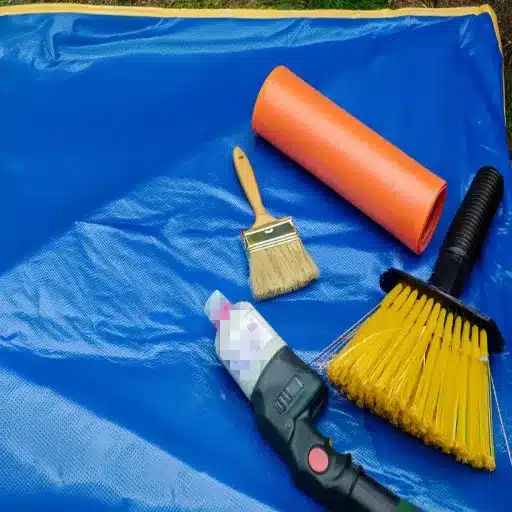
How to Clean and Maintain Tarpaulins
Cleaning and maintenance increase the life of the tarpaulins with maximum working efficiency. The steps given below, based on search engine data, describe the recommended method for maintaining tarps:
1
Regular Cleaning
A mild detergent solution with lukewarm water should be used to wash the tarp. A soft-bristled brush works well for scrubbing off dirt and debris, but one can also use a sponge for scrubbing off dirt or stains. Do not use strong chemicals nor abrasive surfaces that may degrade the tarp, especially UV-treated or waterproof tarps.
2
Proper Drying
Once the tarp is cleaned, make sure it is fully dry before storage. A damp tarp encourages the growth of mold or mildew, which is usually detrimental, especially in vinyl or canvas types.
3
Regular Inspection
Carry out regular inspections. Check for tears, holes, or worn areas. Minor tears should be reinforced with repair tape or patches designed for the tarp material so they don’t get any worse.
4
Proper Storage
Store the tarp in a clean and cool place–away from direct sunlight. Perfectly folding the tarp and putting it in a storage bag can help reduce creases and wear.
5
Avoid Harsh Detergents
In instances of special tarps, such as fire-retardant or chemical-resistant types, heavy use of detergents might strip protective coatings and impair their effectiveness. Use the manufacturer’s cleaning instructions when in doubt.
Important: Following the foregoing maintenance tips will ensure the tarp remains functional and durable for various uses ranging from the industrial stage, outdoor adventure, or disaster relief.
Storage Tips for Longevity
Until the proper repair begins, storage plays an important role in prolonging the service life of tarps, giving them durability and efficacy over time, especially with long or seasonal disuse. From the latest industry data and search preference, here are the detailed, authoritative guidelines:
🏪 Professional Storage Guidelines
🧼 Clean Thoroughly
Remove all dirt, grease, and debris before storage to prevent material degradation
📦 Roll, Don’t Fold
Rolling prevents stress points and cracking, especially in vinyl materials
🏠 Controlled Environment
Store in cool, dry places away from UV light exposure
🔍 Regular Checks
Periodic inspection prevents minor issues from becoming major problems
- Clean and Dry Thoroughly Before Storage: Always clean the tarp with a manufacturer-recommended solution to remove dirt, grease, and debris. Make sure it is dry before folding to prevent mold and mildew growth; such growth may cause weakening of the material’s structural integrity.
- Fold or Roll Correctly: Avoid sharp creases by rolling the tarp rather than folding whenever possible, since repeated folding may lead to stress and cracking at such points, especially in polyethylene or vinyl materials.
- Use a Storage Bag or Container: Store the tarp in a breathable storage bag or a sealed container to protect it from dust, pests, and UV light exposure. Make sure that the environment is dry and cool to avoid thermal degradation.
- Avoid Direct Exposure to Sunlight: Long-term exposure to UV rays would deteriorate the protective coatings of the tarp. Store them away from windows, or any other source of sunlight, to maintain their UV resistance.
- Check Periodically: Periodically inspect the stored tarps for any signs of damage, cracks, or pest infestation. The earlier the problems are dealt with, the better would be prevented for it to become larger, thus saving it in the long term.
Result: Following these proved storage tips can further enhance tarp performance and lifespan, thus saving on replacement and waste.
Identifying Damage and Repairing Tarps
Damage can be identified in a tarp following an in-depth process consisting of detailed evaluations of all possible points of failure. Start by visually inspecting the tarp for any punctures, tears, or fraying, all bearing the common identifying signs of physical damage. Care must be taken especially around areas that encounter the greatest degree of tension or stress, such as corners or grommet spots. Also, look for signs of UV degradation, which will appear as discoloration, brittleness, or cracking, especially on tarps that have been in direct sunlight for long periods.
⚠️ Common Damage Signs
- Punctures and tears
- Fraying edges
- Grommet damage
- UV degradation (discoloration)
- Brittleness and cracking
- Mold or mildew growth
🔧 Modern Repair Solutions
- Specialized adhesives
- Weather-resistant patch kits
- Industrial-strength tapes
- Heavy-duty thread stitching
- Waterproof tape covering
According to data from the latest available sources, modern tarp repair techniques have been improved through the availability of specialized adhesives, patch kits, and industrial-strength tapes. Small tears or punctures can be quickly and effectively fixed with patches of weather-resistant adhesives; for larger tears, stitching with heavy-duty thread and concealing the mended area with a patch or waterproof tape will restore material integrity. Always ensure the damaged area is clean and dry prior to application to optimize repair adhesion and longevity.
🛠️ Repair Process Steps
- Assess the damage: Identify type, size, and location of damage
- Clean the area: Remove dirt and debris from damaged area
- Dry completely: Ensure surface is completely dry before repair
- Apply appropriate repair: Use patches, adhesives, or stitching as needed
- Allow proper curing: Follow manufacturer’s instructions for drying time
- Test the repair: Verify integrity before putting back into service
In order to meaningfully prolong the lifetime of a tarp once repaired, use it within the confines of its design, keep it away from bosses of UV radiation for prolonged periods, and ensure proper storage when it is not in use. Proper upkeep and timely repairs of the damage identified lessen the chances of complete failure greatly, and thus those measures will go a long way in sustaining the tarp’s effective performance into the future.
Where to Find Quality Tarps for Sale
Top Industrial Tarps Sellers
Whether it be in times of need for quality industrial tarps, few have managed to maintain credentials among the top-listed retailers in search engine data and positive customer reviews. These companies are known for the vast selection of products offered, durability considerations, and excellent customer service:
🏆 Tarps Now
Recognized as a premier supplier of industrial tarps, Tarps Now offers quite a selection including waterproof, fire-resistant, and heavy-duty types. Their offerings are suitable for various industries ranging from construction to agriculture and manufacturing. They also give customers the option of customization bearing in mind the project’s uniqueness.
🚛 Mytee Products
Specializing in professional tarps for trucks, agriculture, and industrial use, Mytee Products provide a broad spectrum of both standard and custom tarp solutions. Affordability and versatility of material options, such as vinyl, polyethylene, and mesh tarps, are some of the attributes for which the company has gained renown.
📦 Uline
Having built a brand from a large product catalogue, Uline sells high-quality tarps meant for heavy-duty industrial uses. Their online store is so thorough with specifications that the end-user cannot fail to know and order exactly what he wants.
🛡️ Tarp Supply
A name known for industrial tarps and coverings with exceptional strength and weather resistance, Tarp Supply offers choices for canvas, vinyl, and poly tarps for heavy-duty and demanding conditions.
🛒 Amazon
The market giant has become a leading platform for shopping industrial tarps, filled with the variety of brands, sizes and tarping materials. Although it offers the advantages of convenience and cost-effectiveness, buyers must exercise careful investigation of the products in terms of specifications and reviews from other customers.
Recommendation: Each said retailer gives unique advantages, and making the right choice depends on your specific needs, whether it be through durability, customization requirements, or straightforward budget implications. It would be highly recommended to further review specific technical details pertaining to the same product along with consulting salespersons from the respective stores for a further-tailored product recommendation.
Purchase Online vs. Purchase from In-store
Regarding the comparison between online and in-store shopping, the recent data sourced from the search engine clearly manifests the separate consumer priorities and behaviors. The online shopping has grown even more because of the tremendous accessibility where anyone can browse and can actually buy products at any time of their own, given that there are no location restrictions attached. Spotting trends, searches for best price, or free shipping always rank among the top queries for online shoppers, which implies that consumers are trying to stay cost-effective and value convenience. Online channels offer superb filtering tools to choose features, price, and user reviews, thus allowing consumers to confidently make their own choice.
💻 Online Shopping Advantages
- 24/7 accessibility
- No location restrictions
- Advanced filtering tools
- Price comparison capabilities
- Customer reviews available
- Often better pricing
- Free shipping options
🏬 In-Store Shopping Benefits
- Touch and feel experience
- Immediate product possession
- Personal customer service
- In-store exclusive discounts
- No shipping delays
- Expert consultation available
- Support local businesses
In-store purchases can still prevail if you’re craving that touch-and-feel shopping experience. Data suggests that inquiries regarding “store near me” tend to peak throughout the weekend, indicating shoppers willingness to examine products firsthand and considering immediacy. Additionally, shoppers usually find discounted offers while shopping offline that are not available online. Immediate possession of a product is crucial for the needs of some tourists. Whether online shopping is preferable to shopping in stores is, therefore, determined by the urgency of the matter, along with the extent to which one wishes to have any level of interaction, as well as access to a personalized service. Consumers should judge these elements depending on the respective type of product and their preference.
Evaluating Quality versus Price
Analyzing quality against price essentially calls for a certain approach that merges one’s own appraisal with the most current data. Thanks greatly to the search_engine, splendid information has come down to the aid of consumers in decision-making processes while buying something. Based on the search results, the users can compare product reviews; check out the product specifications; analyze price patterns of the product among several retailers; actually, the shopping tools of search_engine aggregate product ratings and highlight reasonably priced options to give a full picture of quality in comparison with price.
💡 Smart Evaluation Strategy
📊 Compare Reviews
Analyze user experiences and ratings across multiple platforms
🔍 Check Specifications
Verify material quality, thickness, and performance features
💰 Price Analysis
Compare prices across retailers for the same product
🏆 Brand Reputation
Consider manufacturer credibility and warranty offerings
In answering the question of whether higher price dishes out better quality, recent data suggests that the relationship may be situational. For certain products like electronics and luxuries, higher price is often linked with better materials, more features, and longer life. On the other hand, competitive markets usually take pride in having economies of scale means that suitable quality products are offered at the lowest prices, and most of the times, those produce even better performance than the expensive ones. Therefore, paring insights made from search engine with user reviews along with reputation assessment of brands helps establish a very balanced, data-driven decision to find out the product that will give you the best value for your money.
Key Insight: The best approach combines thorough research with practical evaluation to find products that offer optimal value rather than simply the lowest price or highest cost option.
Frequently Asked Questions
❓ Benefits heavy duty tarps would have for construction projects?
Also used for construction, heavy duty tarps do their best work by enduring all sorts of hard work and gory weather. Being durable and strong, they keep a job site safe. Most contractors would like to use heavy duty vinyl tarps since they resist tearing and UV exposure. A gigantic variety of sizes and colors enable one to pick a tarp suitable for his or her needs. They can also be used to cover equipment, shielding tools and machinery from the weather. The investment in heavy duty tarpaulins pays good salt in contrast to buying another one soon.
❓ How insulated tarps differ from standard tarps?
Temperature resistance is just the name of the game for insulated tarps, so they are mainly beneficial in concrete curing and temperature protection for sensitive materials. Standard tarps may slowly help protect materials from moisture and UV rays, but the additional layers in insulated tarps trap heat and inhibit freezing, which few standard tarps can do. So if you were sheltering in lower temperature areas, those tarps would be a vital component for temperature management. From the outdoors, hay tarps would also keep the hay’s quality during storage. Lastly, the added strength and cushion make them perfect for a wider range of industrial applications.
❓ Can I have a custom tarp if I need it for something industrial?
Yes, custom tarps can be fabricated to meet industrial needs so that businesses will be able to select the dimensions, colors, and materials best suited to their requirements. Heavy duty tarps can be requested for use in heavy equipment covers, or lightweight mesh tarps may be supplied for maximum ventilation. Most suppliers accept various fabric types: heavy-duty vinyl with poly coating options, which may increase the durability or functionality of the product. They can also be customized specifically for a field cover or truck tarp used to cover goods during transportation. Hence, you make sure that your tarp meets aesthetic and practical requirements.
❓ What makes industrial strength tarp highly necessary for all outdoor use?
An industrial strength tarp is a crucial tarp that offers protective cover against the elements throughout the year. This tarp, being durable, retains features such as protection against extremely harsh conditions of heavy rain and snow or strong winds. They are designed specifically for rigorous working conditions and any wear and tear being successful they do not allow. Safely protecting the canvas from the construction site to the agricultural fields has been made possible by a variety of sizes and colors in which these tarps exist. Their strong construction allows the tarps also to be used as concrete blankets, wherein they will aid in insulation through the curing process.
❓ What should I consider while making a choice for vinyl tarps?
Various things should come into consideration in helping you make choices for vinyl tarps. Weight, thickness, and use should be considered along with other factors for choosing what concepts are best for what needs. Heavy-duty vinyl tarps are the best for heavy jobs while light-duty ones can serve well for lighter tasks. Count of mesh is another thing to check for strength and resistance of tarps. Besides that, ask yourself: Where will the tarp be in use? Here I mean outdoor projects, construction sites, or hay tarps used in agriculture. Whatever is best wins in manpower and time efficiency and enhances safety for all operations.
Reference Sources
Butler University Blog – Discovering the Best Truck Tarpaulin Options
This guide discusses the versatility and durability of truck tarpaulins, including their construction with materials like PVC and polyethylene.
The New School Portfolio – PVC Tarpaulin: The Ultimate Guide
This resource highlights the high-strength polyester fabric and PVC coating used in tarps, emphasizing their resistance to tears and abrasions.
Boston University Blog – From Market Stalls to Heavy-Duty Covers
This article explores the use of striped tarpaulins for protecting goods from harsh weather conditions, including wind, rain, and UV rays.

